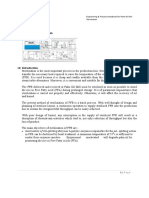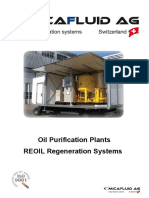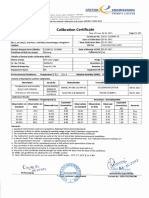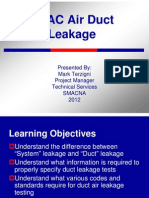Detection of Silicone Oil Leakages in Freeze Dryers: 65 PDA J Pharm Sci and Tech
Detection of Silicone Oil Leakages in Freeze Dryers: 65 PDA J Pharm Sci and Tech
Uploaded by
vijay narayanCopyright:
Available Formats
Detection of Silicone Oil Leakages in Freeze Dryers: 65 PDA J Pharm Sci and Tech
Detection of Silicone Oil Leakages in Freeze Dryers: 65 PDA J Pharm Sci and Tech
Uploaded by
vijay narayanOriginal Title
Copyright
Available Formats
Share this document
Did you find this document useful?
Is this content inappropriate?
Copyright:
Available Formats
Detection of Silicone Oil Leakages in Freeze Dryers: 65 PDA J Pharm Sci and Tech
Detection of Silicone Oil Leakages in Freeze Dryers: 65 PDA J Pharm Sci and Tech
Uploaded by
vijay narayanCopyright:
Available Formats
Downloaded from on June 21, 2021
Detection of Silicone Oil Leakages in Freeze Dryers
U. Meissner, Harald Stahl and D. Steinkellner
PDA J Pharm Sci and Tech 2011, 65 481-485
Access the most recent version at doi:10.5731/pdajpst.2011.00748
Downloaded from on June 21, 2021
Tech Report
Detection of Silicone Oil Leakages in Freeze Dryers
U. MEISSNER1, HARALD STAHL2,*, and D. STEINKELLNER2
1
MKS, Munich, Germany and 2GEA Lyophil GmbH, Huerth, Germany ©PDA, Inc. 2011
ABSTRACT: As a small leakage from the silicone oil tubes in pharmaceutical freeze dryers may go undetected for
several cycles, it provides a major threat to both product safety and the economic performance of such installations.
A properly mounted mass spectrometer offers a non-invasive method of detecting the smallest amounts of silicone
oil down to 1 ppm. Additionally the system will improve leak testing procedures and can also be used as a process
analytical technology tool to improve process control.
LAY ABSTRACT: Drugs, and in particular parenterals, need to have a very high level of purity. A production process
such as freeze drying carries the inherent risk of contamination by process fluids. This should not happen during
routine production, but in the event of a malfunction small amounts of these fluids may contaminate the drug product.
The purpose of this paper is to introduce a method which is able to detect such malfunctions before they can develop
into a risk for drug purity and ultimately patient safety.
KEYWORDS: Freeze drying, Leak detection, Lyophilisation, Mass spectroscopy, Silicone oil
Introduction areas and introduces a system for the detection of
small amounts of silicone oil in the system.
Freeze drying has been used for many years in the
production of parenterals to stabilize thermo labile Silicone oil is heated to the required temperature using
molecules. With the increasing number of large mol- heat exchangers in the technical area, from where it is
ecules, the spread of freeze drying will further con- circulated into the system. A typical setup is shown in
tinue because it offers the gentlest way of converting Figure 1. One of the most important aspects of freeze
a liquid formulation into a more stable solid. drying processes is the heating and cooling of this oil
in the shelves. From an engineering perspective, the
From an engineering point of view the preparation and shelves need to be as lightweight as possible while
ensuring a uniform surface temperature and planarity.
process of a freeze dryer places very high physical
The shelves are moved up and down during the load-
demands on the hardware. After washing, all potential
ing and unloading cycles as well as during stoppering
product contact parts are exposed to saturated steam at
and subsequent CIP/SIP at the end of the process. This
121 °C, which relates to an overpressure of ⬃1.5 bar.
means that the tubes supplying the silicone oil to the
After vial loading, the dryer is evacuated down to
shelves need to be constructed and guided in a way
0.05 mbar while the shelves and the ice condenser are
that reduces stress that could increase the risk of
cooled down to as low as ⫺85 °C (1). Various types of
cracks in the tubes.
silicone oils are used to transfer the required heat
energy in and out of the dryer. Following multiple Older freeze dryers in particular have been known to
cycles under extreme conditions it has been seen that develop small cracks as a result of numerous cycles
micro leaks can occur in the silicone oil circulation and movements. It is through these cracks that silicone
system. This article identifies the most likely leak oil can escape into the drying chamber. In the begin-
ning these leaks are relatively small and will not cause
malfunctions of the system. This means there is the
risk that several batches might be produced before
* Corresponding author: Dr. Harald Stahl,
Quality Control (QC) identifies the problem. The QC
Kalscheurener Strasse 92, D-50354 Huerth, Germany;
unit would then have to decide at what moment in time
⫹49 172 620 6864; harald.stahl@geagroup.com
(from what batch onwards) the problem initially
Vol. 65, No. 5, September–October 2011 481
Downloaded from on June 21, 2021
Figure 1 Figure 3
Typical setup of a freeze dryer. MKS Instruments Inc. Vision 2000-P.
started. For these reasons it would be helpful to have ionization, the separation of the formed ions in an
a method allowing the detection of traces of silicone electromagnetic field, and their detection.
oil from the moment the first leak occurs.
Early trials proved the principle eligibility of the
Feasibility Trials: The Detection of Silicone Oil method and allowed the determination of its sensitiv-
Traces ity. An MKS Vision 2000-P mass spectrometer, as
shown in Figure 3, was connected via a standard
Mass spectroscopy (principle shown in Figure 2) was flange with an FCM-2 freeze dryer (Figure 4) installed
chosen as a method of detection because of its sensi- in the test centre at GEA Lyophil in Hürth (Germany).
tivity. Quadrupole mass spectrometer systems are
widely used for the monitoring of critical processes When silicone oil is introduced into the mass spec-
and the detection of residual contamination. The prin- trometer the molecule is broken into several frag-
ciple of the operation is based on electron impact ments. By detecting characteristic fragments, traces of
Figure 2
Function of a quadrupole mass spectrometer.
482 PDA Journal of Pharmaceutical Science and Technology
Downloaded from on June 21, 2021
peak at 73 AMU (atomic mass units) was found.
Additionally, other types of silicone oil that may be
present in a freeze dryer were tested. While the oil
typically used for the siliconisation of stoppers gave a
characteristic peak at 56 AMU, silicone oil-based
maintenance spray—typically used for lubrication of
moving parts in loading and unloading systems— gave
a characteristic peak at 58 AMU. As the characteristic
peak at the mass of 73 AMU represents the type of oils
used in the temperature circuits of a freeze dryer, this
signal was used for the subsequent measurements.
As a next step an amount of 2 mg of KT5 was
introduced into a vial, which was closed by a stopper
Figure 4 and held in position by the upper shelf. After the
desired vacuum level was reached, the upper shelf was
GEA Lyophil Lab Scale Freeze Dryer Type FCM-2. lifted. As a result, the stopper popped off and the oil
evaporated into the freeze dryer. After just a few
silicone oil can be found. During the tests different seconds a signal was detected.
types of silicone oils were used. As KT5 (Bayer AG,
Leverkusen, Germany) has the lowest vapour pressure During an additional simulation 100 mg—less than 10
of common oils for freeze drying, it was used for all droplets—KT5 was introduced over a small buffer
measurements. After the first trials a characteristic volume into the drying chamber with a shelf size of 40
Figure 5
Test with 100 mL Baysilone KT5 on a freeze dryer with 40 m2 shelf size.
Vol. 65, No. 5, September–October 2011 483
Downloaded from on June 21, 2021
TABLE I For the determination of sensitivity it was decided that
Detection Limit as a Function of Dryer Size the signal would be measured after the chamber was
contaminated with a known amount of silicone oil that
Shelf Chamber
should be at least 5 times higher than the average
Area Volume
background noise level detected. The time until this
Unit [m2] [m3] [mg]
condition was reached is given as “Max time” in Table
FCM-2 0.1 0.08 0,4 II. After 12 h of evacuation the noise level was slightly
GT-10 0.8 0.21 1 below 0.2 ppm, resulting in the ability to safely detect
GT-300-D 24.8 9.1 45 silicone oil contamination down to 1 ppm. This trans-
FCM-400-D 20 6.1 30 lates in absolute numbers to 1 mg for a GT/FCM 10,
FCM-500-D 44 12.2 60 and 60 mg for a FCM 500-D. An average drop of
silicone oil generated by a pipette has a weight of 10
mg.
m2. While the drying chamber was evacuated to the A summary of the results obtained is given in Table II.
desired vacuum level, the vial containing the silicone
oil was stored in an attached small compartment sep- Evaluation of Further Possibilities
arated by a valve. After the desired vacuum level had
been reached in the main drying chamber, the sepa- Performing a leak test is a standard procedure when
rating valve was opened. As a result the pressure of the assuring the integrity of a freeze drying chamber. The
small compartment (now connected with the main test requires the chamber and condenser to be evacu-
chamber) dropped, which resulted in the vaporization ated to a pre-defined pressure, all valves closed, and
of the silicone oil. This test confirmed again the char- the rise in pressure monitored. To assure a meaningful
acteristic signal pattern of silicone oil (Figure 5). measurement this is often done for between 2 and 4 h.
A mounted mass spectrometer offers a much faster
Measurements on Production Units way. Tests proved that a total measurement time of 20
min is sufficient if a mass spectrometer is used. Before
The detection system was mounted onto production evacuation the chamber is flushed with nitrogen. After
size freeze driers. Drier sizes tested are shown in the desired vacuum level has been reached all valves
Table I. While two of these driers were installed at are closed and the composition of the remaining gas
GEA Lyophil, the other three are manufacturing units (⬎99% nitrogen) is monitored. As a result of small
installed at European production sites of two multina- leaks (which can be found in every industrial freeze
tional pharmaceutical companies. dryer), air flows into the chamber can be detected by
monitoring the rise in concentration of oxygen.
Dynamic effects have to be taken into consideration as
a result of the larger dimensions of production-scale Summary and Outlook
driers. To achieve an enhanced sensitivity, the mea-
surement is done when the mushroom valve between A model for the quantitative analysis of the oxygen
the product chamber and condenser chamber is closed. signals has been developed. Due to the sensitivity
TABLE II
Measurements in Chambers of Different Sizes
Unit Max
Test Size Amount Time Peak
No. Unit Type [m2] [mg] AMU [sec] [ppm]
1 FCM-2 0.5 2 73, 71, 75 0 ⬎10
2 GT 10 0.8 2 73, 71, 75 5 5
3 GT 300-D 24.8 49 73, 71, 75 20 2.9
4 FCM 400-D 20 51 73, 71, 75 42 3.3
5 FCM 500-D 44 100 73, 71, 75 89 3.1
484 PDA Journal of Pharmaceutical Science and Technology
Downloaded from on June 21, 2021
and fast response of the instrument, it can addition- Declaration of Interest
ally be used to determine the location of leaks in the
chamber. The authors declare that they have no competing in-
terests.
In addition, the spectrometer can also detect the con-
centration of water in the freeze drying chamber. This References
means that it can be used as a process analytical
technology tool for monitoring the drying cycle and 1. Handbook of Vaccuum Technology, 1st ed.;
the safe and non-invasive detection of the end points Jousten, J., Ed.; Wiley-VCH Verlag GmbH & Co.
of primary and secondary drying. KGaA,Weinheim, Germany, 2008.
The system is currently retrofitted to two production- 2. NIST Chemistry WebBook; NIST (National Insti-
scale freeze driers owned by multinational pharmaceu- tute of Standards and Technology) Standard Ref-
tical companies, with additional companies currently erence Database Number 69, http://webbook.nist.
evaluating the potential of the method. (1, 2) gov/chemistry.
Vol. 65, No. 5, September–October 2011 485
Downloaded from on June 21, 2021
An Authorized User of the electronic PDA Journal of Pharmaceutical Science and
Technology (the PDA Journal) is a PDA Member in good standing. Authorized Users are
permitted to do the following:
·Search and view the content of the PDA Journal
·Download a single article for the individual use of an Authorized User
·Assemble and distribute links that point to the PDA Journal
·Print individual articles from the PDA Journal for the individual use of an Authorized User
·Make a reasonable number of photocopies of a printed article for the individual use of an
Authorized User or for the use by or distribution to other Authorized Users
Authorized Users are not permitted to do the following:
·Except as mentioned above, allow anyone other than an Authorized User to use or access the
PDA Journal
· Display or otherwise make any information from the PDA Journal available to anyone other
than an Authorized User
·Post articles from the PDA Journal on Web sites, either available on the Internet or an Intranet,
or in any form of online publications
·Transmit electronically, via e-mail or any other file transfer protocols, any portion of the PDA
Journal
·Create a searchable archive of any portion of the PDA Journal
·Use robots or intelligent agents to access, search and/or systematically download any portion
of the PDA Journal
·Sell, re-sell, rent, lease, license, sublicense, assign or otherwise transfer the use of the PDA
Journal or its content
·Use or copy the PDA Journal for document delivery, fee-for-service use, or bulk reproduction or
distribution of materials in any form, or any substantially similar commercial purpose
·Alter, modify, repackage or adapt any portion of the PDA Journal
·Make any edits or derivative works with respect to any portion of the PDA Journal including any
text or graphics
·Delete or remove in any form or format, including on a printed article or photocopy, any
copyright information or notice contained in the PDA Journal
You might also like
- Repair Manual Cummins ISX QSX15Document16 pagesRepair Manual Cummins ISX QSX15angel017100% (3)
- Aoi ManualDocument62 pagesAoi Manualshaktiss24_1479303590% (1)
- Hydrocracker SafeguardingDocument14 pagesHydrocracker SafeguardingyusinovskyNo ratings yet
- PDA Technical SeriesDocument6 pagesPDA Technical Seriesvijay narayan50% (2)
- Impact of Vial CappingDocument20 pagesImpact of Vial Cappingvijay narayanNo ratings yet
- Hazards in Processing Light HydrocarbonsDocument4 pagesHazards in Processing Light HydrocarbonsNestramiNo ratings yet
- The Molecular Separation of Hemp Oil: John F. Hart, Chemtech Services, IncDocument9 pagesThe Molecular Separation of Hemp Oil: John F. Hart, Chemtech Services, IncMihai DomsaNo ratings yet
- Batch Vacuum CrystalizerDocument9 pagesBatch Vacuum CrystalizermohammedNo ratings yet
- Bhopal Gas Tragedy - The Scar of Process Safety: SIESO MedalDocument3 pagesBhopal Gas Tragedy - The Scar of Process Safety: SIESO MedalsamibenhabileNo ratings yet
- Nitrogen Tank Blanketing 0415Document4 pagesNitrogen Tank Blanketing 0415NursahidNo ratings yet
- FTA129eng Pharm GuidelinesDocument8 pagesFTA129eng Pharm GuidelinesNaser JahangiriNo ratings yet
- Mak Freezol 68 OilDocument1 pageMak Freezol 68 OilshobhaNo ratings yet
- Factory Dehydrating, Charging, and TestingDocument7 pagesFactory Dehydrating, Charging, and TestingdarthmoodyNo ratings yet
- ProjectDocument35 pagesProjectAKHIL JOSEPHNo ratings yet
- Process SimulationDocument9 pagesProcess SimulationAlexandra Marquez GrandaNo ratings yet
- System Identification of A Falling-Film Evaporator in The Dairy IndustryDocument8 pagesSystem Identification of A Falling-Film Evaporator in The Dairy IndustrySiddNo ratings yet
- Production DepartmentDocument54 pagesProduction DepartmentAshik SureshNo ratings yet
- Automatic Control System For Spray Drier Pilot Plant: Supriya Pote, Sneha SuditDocument5 pagesAutomatic Control System For Spray Drier Pilot Plant: Supriya Pote, Sneha SuditerpublicationNo ratings yet
- Keeler - Cryo Instruction Manual - 2509-P-8012-art-D - English1 PDFDocument24 pagesKeeler - Cryo Instruction Manual - 2509-P-8012-art-D - English1 PDFamirali.bme4527No ratings yet
- Batch Drying With Vacuum Contact DryersDocument7 pagesBatch Drying With Vacuum Contact DryersBramJanssen76No ratings yet
- Galary - INVESTIGATION INTO THE DYNAMIC PARTICLE GENERATION OF LUBRICATING GREASES USED IN SPACE MECHANISMSDocument7 pagesGalary - INVESTIGATION INTO THE DYNAMIC PARTICLE GENERATION OF LUBRICATING GREASES USED IN SPACE MECHANISMSgoooga299No ratings yet
- Implant Training RobinDocument10 pagesImplant Training RobinRobin MejoNo ratings yet
- How To Verify System Cleanliness After An Oil FlushDocument7 pagesHow To Verify System Cleanliness After An Oil FlushchrisNo ratings yet
- Food Feed: Oils Fats ProcessesDocument8 pagesFood Feed: Oils Fats ProcessesRosario MalarczukNo ratings yet
- Improvement of Essential Oil Steam Distillation by Microwave PretreatmentDocument6 pagesImprovement of Essential Oil Steam Distillation by Microwave PretreatmentManoakiNo ratings yet
- Abschreckmedien EDocument24 pagesAbschreckmedien EhsemargNo ratings yet
- Melt CrystallizationDocument10 pagesMelt CrystallizationBryan DallaraNo ratings yet
- Water Treatment News 37 - Make Certain Your Cooling System Is Protected During Lay-UpDocument4 pagesWater Treatment News 37 - Make Certain Your Cooling System Is Protected During Lay-UpQuốc Anh KhổngNo ratings yet
- Memberane Filter at Ion in DewaxingDocument8 pagesMemberane Filter at Ion in DewaxingrvsinghNo ratings yet
- Chapter - 10 (T2 Laboratories)Document27 pagesChapter - 10 (T2 Laboratories)BigbearBigbearNo ratings yet
- Constant Flux ReactorDocument4 pagesConstant Flux ReactorRaghav SharmaNo ratings yet
- Omm-Sterilizer PKS MalataDocument26 pagesOmm-Sterilizer PKS Malatawww.freebiexp.netNo ratings yet
- Oil Mist Lubrication TutorialDocument14 pagesOil Mist Lubrication Tutorial최승원100% (1)
- Articulo PDFDocument6 pagesArticulo PDFleidy cabrilesNo ratings yet
- Engineers Nova Scotia: Detailed Engineering Experience RecordDocument1 pageEngineers Nova Scotia: Detailed Engineering Experience Recordndoan_44No ratings yet
- Standard Test Procedures Manual: 1. Scope 1.1. Description of TestDocument6 pagesStandard Test Procedures Manual: 1. Scope 1.1. Description of TestProcess EngineerNo ratings yet
- 2509 P 8012 Art L - EnglishDocument31 pages2509 P 8012 Art L - EnglishSheyda MavisatNo ratings yet
- Industrial Saturated Steam SterilizersDocument6 pagesIndustrial Saturated Steam SterilizersIngrid Yulieth Herrera GarnicaNo ratings yet
- Steriliser Type 1Document21 pagesSteriliser Type 1Amin Buhari Md Zain100% (2)
- Chemical Engineering Science: Marcello Murru, Giovanni Giorgio, Sara Montomoli, Francois Ricard, Frantisek StepanekDocument10 pagesChemical Engineering Science: Marcello Murru, Giovanni Giorgio, Sara Montomoli, Francois Ricard, Frantisek StepanekNishant Kumar GuptaNo ratings yet
- Paper No.: Elucidating The Corrosion Phenomena in A Thermal in Situ Oil Sands Emulsion PipelineDocument15 pagesPaper No.: Elucidating The Corrosion Phenomena in A Thermal in Situ Oil Sands Emulsion PipelinetinovelazquezNo ratings yet
- PSSR of Petrochem PlantDocument6 pagesPSSR of Petrochem PlantAkhtar QuddusNo ratings yet
- Antilux 654 A Formerly 654 Pe en RCRDocument2 pagesAntilux 654 A Formerly 654 Pe en RCRPedro Javier Rodriguez leonNo ratings yet
- Determining Silicone Volatiles in Silicone Rubber For Transportation ApplicationsDocument3 pagesDetermining Silicone Volatiles in Silicone Rubber For Transportation ApplicationsAMUL VEKARIANo ratings yet
- CJC Fine Filters Thermal OilDocument8 pagesCJC Fine Filters Thermal OildfNo ratings yet
- A Simulation Study of The (103A) Field, Zuetina Terminal Crude Oil PipelineDocument7 pagesA Simulation Study of The (103A) Field, Zuetina Terminal Crude Oil PipelineteaNo ratings yet
- Parameters - Affecting - The - Static - Electrification Due To Aged Transformer OilsDocument4 pagesParameters - Affecting - The - Static - Electrification Due To Aged Transformer Oilschandraippa2No ratings yet
- Engineering Practice Jan 2022Document45 pagesEngineering Practice Jan 2022devenderdevgunNo ratings yet
- Shell Thermia B Pds PDFDocument3 pagesShell Thermia B Pds PDFBoon Kuan LimNo ratings yet
- 01 IntroductionDocument6 pages01 IntroductionHamilton MupoperiNo ratings yet
- AutoclaveDocument20 pagesAutoclaveNita Agarwal100% (1)
- Oil Film Bearing Lubrication, Morgoil 'S Latest Systems: ConfidentialDocument7 pagesOil Film Bearing Lubrication, Morgoil 'S Latest Systems: Confidentialirina.ruturNo ratings yet
- Norgren - Guide To Clean Compressed AirDocument24 pagesNorgren - Guide To Clean Compressed AirYongWei-Jin100% (1)
- Mech Seal BFPDocument13 pagesMech Seal BFPmohammad imronNo ratings yet
- Environmental Test Facilities: Cooling SystemsDocument7 pagesEnvironmental Test Facilities: Cooling SystemsFlorin OnucNo ratings yet
- Kleenoil Micron Filtration SystemsDocument16 pagesKleenoil Micron Filtration SystemsRomuald PogorzelczykNo ratings yet
- Ip 390Document4 pagesIp 390basharat121No ratings yet
- Systems Operation Testing and AdjustingDocument20 pagesSystems Operation Testing and Adjustingait mimouneNo ratings yet
- Biopharmaceutical Development Program: SOP Title: Operation of C1000 Touch Thermal Cycler SOP Number: 23013 Revision: 00Document8 pagesBiopharmaceutical Development Program: SOP Title: Operation of C1000 Touch Thermal Cycler SOP Number: 23013 Revision: 00pjenem1No ratings yet
- Oil Purification Plants REOIL Regeneration SystemsDocument35 pagesOil Purification Plants REOIL Regeneration SystemsFer PolNo ratings yet
- Introduction to Petroleum Process SafetyFrom EverandIntroduction to Petroleum Process SafetyRating: 3 out of 5 stars3/5 (2)
- Integrated Chemical Processes: Synthesis, Operation, Analysis and ControlFrom EverandIntegrated Chemical Processes: Synthesis, Operation, Analysis and ControlKai SundmacherNo ratings yet
- Castor: Calibration CertificateDocument1 pageCastor: Calibration Certificatevijay narayanNo ratings yet
- dk2019_ch07Document23 pagesdk2019_ch07vijay narayanNo ratings yet
- Duct Leakage PPDocument62 pagesDuct Leakage PPhbithoNo ratings yet
- Mass Transfer in Freeze-Drying A Discussion of The Effect of Chamber Pressure On Heat andDocument5 pagesMass Transfer in Freeze-Drying A Discussion of The Effect of Chamber Pressure On Heat andvijay narayanNo ratings yet
- US FDA 483 To Sun Pharma HalolDocument5 pagesUS FDA 483 To Sun Pharma Halolvijay narayanNo ratings yet
- Usfda Inspection at Alathur Facility With Zero 483 ObservationsDocument3 pagesUsfda Inspection at Alathur Facility With Zero 483 Observationsvijay narayanNo ratings yet
- Wockhardt 483Document6 pagesWockhardt 483vijay narayanNo ratings yet
- US FDA 483 To Gadea Biopharma S.L., SpainDocument3 pagesUS FDA 483 To Gadea Biopharma S.L., Spainvijay narayanNo ratings yet
- Ausmetics Daily Chemicals FDA 483 2017Document3 pagesAusmetics Daily Chemicals FDA 483 2017vijay narayanNo ratings yet
- Walk-In-Incubator Slide PDFDocument8 pagesWalk-In-Incubator Slide PDFvijay narayanNo ratings yet
- US FDA 483 To Qualgen LLCDocument10 pagesUS FDA 483 To Qualgen LLCvijay narayanNo ratings yet
- Cold Chain ValidationDocument20 pagesCold Chain Validationvijay narayan100% (2)
- Conductivity MeterDocument21 pagesConductivity Metervijay narayanNo ratings yet
- MD - Robiul Islam CVsDocument3 pagesMD - Robiul Islam CVsMd.Robiul IslamNo ratings yet
- Convaero & Backhus Con SeriesDocument7 pagesConvaero & Backhus Con Seriessatya febriansyahNo ratings yet
- Aspek Geologi Pantai Bodri - KendalDocument10 pagesAspek Geologi Pantai Bodri - KendalMochamad Luthfi HamidNo ratings yet
- EC Module 1 ModifiedDocument87 pagesEC Module 1 ModifiedVICHUNo ratings yet
- Madeleine LeiningerDocument4 pagesMadeleine LeiningersusulanjrNo ratings yet
- Experiment No.6Document4 pagesExperiment No.6Cabacungan, Michael RayNo ratings yet
- Line Sizing Tool Hydrogen Line 800 m3Document31 pagesLine Sizing Tool Hydrogen Line 800 m3Ahmed HassanNo ratings yet
- GIS-RA-4061E-004 Risk Assessment For Road Crossing Area (Rev.00)Document6 pagesGIS-RA-4061E-004 Risk Assessment For Road Crossing Area (Rev.00)Ajas Aju100% (1)
- Geotechnical Design of Foundations:: Provisions in BNBC 2020Document70 pagesGeotechnical Design of Foundations:: Provisions in BNBC 2020ahnafNo ratings yet
- Handout 9 IV2Document18 pagesHandout 9 IV2CHUA WEI JINNo ratings yet
- A Cognitive Approach to Compounds and BlendsDocument101 pagesA Cognitive Approach to Compounds and BlendsHicham LahlouNo ratings yet
- Cel2106 Weekly Schedule Sem 1, 2023-2024Document16 pagesCel2106 Weekly Schedule Sem 1, 2023-2024211006No ratings yet
- Learning Action CellDocument2 pagesLearning Action CellJinsen Paul MartinNo ratings yet
- Mini Galaxy e 050600Document19 pagesMini Galaxy e 050600Роман ПрокопчукNo ratings yet
- REV2 AVK Philippines Pricelis 20232024Document63 pagesREV2 AVK Philippines Pricelis 20232024cceccsurvey2024No ratings yet
- ChanduDocument2 pagesChanduGyaneshwar ThunikiNo ratings yet
- Question Set Manufacturing System Analysis & ManagementDocument10 pagesQuestion Set Manufacturing System Analysis & Managementnidhi.cse23No ratings yet
- Pokemon Emerald Seaglass Documentation v2.0Document27 pagesPokemon Emerald Seaglass Documentation v2.0AdriánNo ratings yet
- Eco JusticeDocument20 pagesEco JusticeNand NityaNo ratings yet
- Slope Stability Mangement Within A Tailings (Dam) Safety Management System PDFDocument24 pagesSlope Stability Mangement Within A Tailings (Dam) Safety Management System PDFMarceloToribioFlores100% (1)
- Practically Speaking Chapter 1: Public Speaking: An Act of Communication Where There Is An Identified Speaker FormallyDocument4 pagesPractically Speaking Chapter 1: Public Speaking: An Act of Communication Where There Is An Identified Speaker Formallyanelim villaNo ratings yet
- Quadratic Simultaneous EquationsDocument19 pagesQuadratic Simultaneous EquationsSri Devi NagarjunaNo ratings yet
- Buyers Guide 19 127130 PDFDocument277 pagesBuyers Guide 19 127130 PDFAnton Frian Yohanes ReynaldoNo ratings yet
- Common Mistakes in Structural Engg-8 - 7 - 09Document21 pagesCommon Mistakes in Structural Engg-8 - 7 - 09krishna kumarNo ratings yet
- StandardReport - 3 2 2021 - 23 27 58Document1 pageStandardReport - 3 2 2021 - 23 27 58mont krstoNo ratings yet
- Effects of Footing Size and Aspect Ratio On The Bearing Capacity of SandDocument15 pagesEffects of Footing Size and Aspect Ratio On The Bearing Capacity of SandSaswati DattaNo ratings yet
- FTL Nomad QuickstartDocument83 pagesFTL Nomad QuickstartKevin BrennanNo ratings yet
- Report Text About WhalesDocument3 pagesReport Text About WhalesRyuzaki50% (4)
- SYMBIOSIS International: HEI Basic InformationDocument27 pagesSYMBIOSIS International: HEI Basic Informationnilesh mishraNo ratings yet








































































































